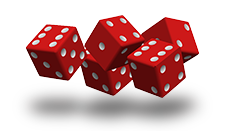Texas Hold’em Poker Strategy Made Easy
Learn proper Texas Hold’em Poker strategy and you will be a better player than most of the tens of thousands who play Texas Hold’em.
This page aims to help you to improve your skills and become a winning Texas Hold’em player. The idea is to learn how to win, rather than merely knowing how to play poker. If you’re new to the game, but would like to learn Texas Hold’em poker this and similar web pages are a good way to start.
Another, and perhaps more interesting way to learn Texas Hold’em strategy, is by first watching and then participating in the free games offered at online poker rooms. It won’t cost you anything unless you eventually decide to try your luck for real money. Pick one of the active tables and watch and learn how others play poker hands. When you’re ready to participate, click an open seat on a free-play table and join in.
 |
Texas Hold’em Poker is by far the most popular of all poker games in live casinos and online.
If you’re going to play this game, start with the basics and then I’ll tell you a way to learn Texas holdem strategy that is fun and will make you a skillful player in a hurry.
At the start of the game, each player has two down cards that are his or hers alone and combines them with the five cards that every player at the table will use to make the best possible five-card hand. Texas Hold’em Poker is a “community card” game, meaning that some cards are dealt face-up in the middle of the table and shared by all the players.
Texas Hold’em opening play (Hole or Pocket Cards)
Play begins by dealing two cards face down to each player. These are known as “hole cards” or “pocket cards”. A round of betting begins at this point.
Most Texas Hold’em games get the betting started with one or two “blind bets” to the left of the dealer. These are forced bets that must be made before players see their cards. Play proceeds clockwise from the blinds, with each player free to either fold, call the blind bet, or raise. Usually the blinds are “live”, meaning they may raise themselves when the action gets back around to them.
Texas Hold’em Flop
Now three cards are dealt face up in the middle of the table; this is called the “flop”.
Texas Hold’em Turn and The River
A round of betting ensues, with action starting on the first blind, immediately to the dealer’s left. Another card is dealt face up (the “turn”), followed by another round of betting, again beginning to the dealer’s left. Then the final card (the “river”) is dealt followed by the final round of betting. In a structured-limit game, the bets on the turn and river are usually double the size of those before and on the flop.
Players usually use both their hole cards to make their besthand, but this is not required. The game is usually played for high only, each player making the best five-card combination to compete for the pot. A player may even choose to “play the board” and use no hole cards at all. Identical five-card hands split the pot; the sixth and seventh cards are not used to break ties.
Practice your Texas Hold’em Poker Strategy
You can easily practice and develop a Texas Hold’em strategy at your kitchen table. Deal yourself a bunch of two-card hands and ask yourself which you think are the strongest hands and why. Then find a Texas Hold’em game in an online card room and observe closely. Take note of the starting hands that players favor. It won’t be long before you can take a seat among them. Play the free games to start with, but after a while find the lowest (5-cent, 10-cent or 25-cent) limit game.
Low-limit games are better than free games for improving your Texas Hold’em strategy. Why? Because when it’s for money, even very little money, most of the players are seriously playing to win. It’s a low-risk way to hone your Texas Hold’em strategy skills.



 -->
-->